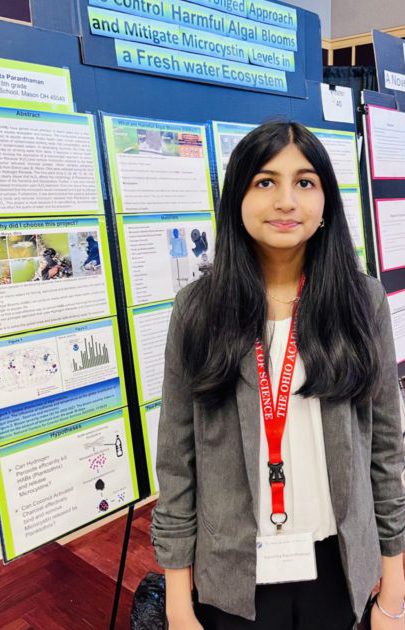
8th grade, Mason Middle School Student uses Attogene Microcystin Lateral Flow kits to make impactful finding and is selected as a Thermo Fisher Scientific Junior Innovators Challenge finalist
Samhita Paranthaman has been selected as one of 30 finalists (out of 2000 entrants) in the Thermo Fisher Scientific Junior Innovators Challenge (Thermo Fisher JIC), the nation’s premier middle school science, technology, engineering, and mathematics (STEM) competition.
8th Grade, Mason Middle School
Mason, OH
A Novel Two-Pronged Approach To Control Harmful Algal Blooms (HABs) and Mitigate Microcystin Levels in a Freshwater Ecosystem
Project Background: During the COVID pandemic, Samhita got a foldscope — a tiny paper microscope — and excitedly used it to look at tiny creatures. “Out of curiosity, I collected water samples from a lake and prepared some slides to check for Harmful Algal Blooms since I had read about them,” she says. Samhita then learned that more than 2 billion people around the world don’t have access to clean water and decided to find a way to control harmful algal blooms.
Tactics and Results: Samhita, accompanied by her dog, collected water from Grand Lake in Ohio. She was looking for Planktothrix — a type of bacteria that forms harmful algal blooms. The algae produce the toxin microcystin, which can cause liver damage in people. Samhita treated some of the lake water with six percent hydrogen peroxide and compared it to control lake water for seven days. The peroxide made the algae break apart into filaments, but also made them release more than 50 parts per billion microcystin. Samhita then tested whether she could filter the microcystin out of the water using a coconut activated charcoal filter. She showed that the filter could bind to the microcystin and remove it from the water. Her method, Samhita says, “is cost-effective, environmentally friendly and does not affect the quality of water and the ecosystem.”
Other Interests: Samhita loves to sketch and make jewelry. She started a non-profit with her sister called “Artsy Altruists.” “We have a team of like-minded individuals who help create and sell artwork/jewelry to raise funds for our school foundation, which helps at-risk students, and we also support local and international charities,” she says. Samhita learned to speak and write Tamil and volunteers at a local Tamil school to help younger kids.